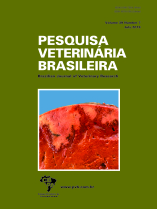 |
|
|
|
Year 2019 - Volume 39, Number 7
|

|
Morphology and biometry of the reproductive organs of adult males of Trachemys scripta elegans reared in São Paulo state, Brazil, 39(7):538-548
|
ABSTRACT.- Gradela A., Pires I.C., Faria M.D., Matos M.H.T., Costa M.M., Souza R.K.C., Milanelo L. & Franzo V.S. 2019. Morphology and biometry of the reproductive organs of adult males of Trachemys scripta elegans reared in São Paulo state, Brazil. [Morfologia e biometria dos órgãos reprodutivos de machos adultos de Trachemys scripta elegans criados em São Paulo, Brasil.] Pesquisa Veterinária Brasileira 39(7):538-548. Laboratório de Anatomia dos Animais Domésticos e Silvestres, Colegiado de Medicina Veterinária, Universidade Federal do Vale do São Francisco, Rodovia 407 Km 12, Lote 543, Projeto Nilo Coelho C1, Petrolina, PE 56300-000, Brazil. E-mail: agradela@hotmail.com
Trachemys scripta elegans is an American underwater chelonian illegally marketed in Brazilian pet shops. When abandoned in nature, it compromises native species, threatening local biodiversity. However, little is known about the body development and structure of its reproductive tract. The objective of the present study was to investigate the morphology and biometry of testis, epididymis and penis, as well as the biometry of the body and secondary sexual characters in this species. Twenty-seven adult males were used aiming to contribute to preservation actions in captivity, population control, and scientific research, as well as to interspecific comparisons. Sex identification by the third claw length was effective, and the specimens presented harmonious and positive body development between mass, carapace, plastron, and height, with unimodal tendency and higher frequency of maximum carapace length at 15cm. The testes and epididymides presented biometric similarity between the antimeres and anatomical and histological structure similar to that of other species of chelonians and mammals, except for the type of epithelium. The findings suggest that there is conserved morphology between slider turtles and homology in relation to mammals. Histological similarity to the reproductive organs of other amniotes, including humans, may give rise to scientific and comparative studies, essential for the establishment of conservation strategies in reptiles. |
| |
|
|
| |
|
 |